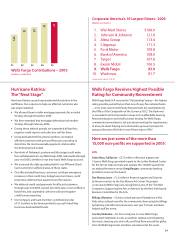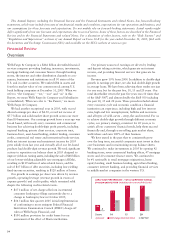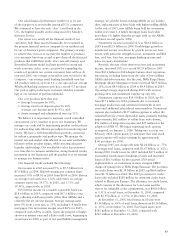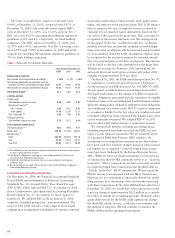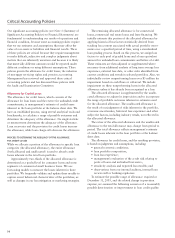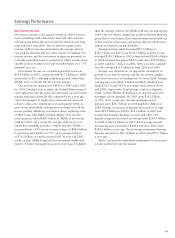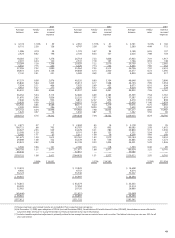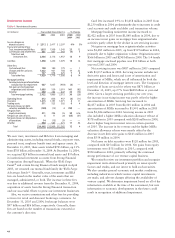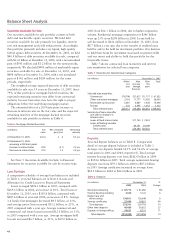Wells Fargo 2005 Annual Report Download - page 41
Download and view the complete annual report
Please find page 41 of the 2005 Wells Fargo annual report below. You can navigate through the pages in the report by either clicking on the pages listed below, or by using the keyword search tool below to find specific information within the annual report.
39
Assumptions for deterioration in loan credit quality were:
• for retail loans, a 12 basis point increase in estimated
loss rates from actual 2005 loss levels, moving closer to
longer term average loss rates; and
• for wholesale loans, a 30 basis point increase in esti-
mated loss rates, moving closer to historical averages.
Assumptions for improvement in loan credit quality were:
• for retail loans, an 8 basis point decrease in estimated
loss rates from actual 2005 loss levels, adjusting for
incremental consumer bankruptcy losses; and
• for wholesale loans, no change from the essentially zero
2005 net loss performance.
Under the assumptions for deterioration in loan credit
quality, another $550 million in expected losses could occur
and under the assumptions for improvement, a $170 million
reduction in expected losses could occur.
Changes in the estimate of the allowance for credit
losses can materially affect net income. The example above
is only one of a number of reasonably possible scenarios.
Determining the allowance for credit losses requires us to
make forecasts that are highly uncertain and require a high
degree of judgment.
Valuation of Mortgage Servicing Rights
We recognize as assets the rights to service mortgage loans
for others, or mortgage servicing rights (MSRs), whether we
purchase the servicing rights, or keep them after the sale or
securitization of loans we originate. Purchased MSRs are
capitalized at cost. Originated MSRs are recorded based on
the relative fair value of the retained servicing right and the
mortgage loan on the date the mortgage loan is sold. Both
purchased and originated MSRs are carried at the lower of
(1) the capitalized amount, net of accumulated amortization
and hedge accounting adjustments, or (2) fair value. If MSRs
are designated as a hedged item in a fair value hedge, the
MSRs’ carrying value is adjusted for changes in fair value
resulting from the application of hedge accounting. The
carrying value of these MSRs is subject to a fair value test
under FAS 140, Accounting for Transfers and Servicing of
Financial Assets and Extinguishments of Liabilities.
MSRs are amortized in proportion to and over the period
of estimated net servicing income. We analyze the amortization
of MSRs monthly and adjust amortization to reflect changes
in prepayment speeds, discount rates and other factors that
affect estimated net servicing income.
We determine the fair value of MSRs using a valuation
model that calculates the present value of estimated future
net servicing income. The model incorporates assumptions
that market participants use in estimating future net servicing
income, including estimates of prepayment speeds, discount
rate, cost to service, escrow account earnings, contractual
servicing fee income, ancillary income and late fees. The
valuation of MSRs is discussed further in this section and in
Note 1 (Summary of Significant Accounting Policies), Note 20
(Securitizations and Variable Interest Entities) and Note 21
(Mortgage Banking Activities) to Financial Statements.
At the end of each quarter, we evaluate MSRs for possible
impairment based on the difference between the carrying
amount and current estimated fair value. To evaluate and
measure impairment, we stratify the portfolio based on
certain risk characteristics, including loan type and note rate.
If temporary impairment exists, we establish a valuation
allowance through a charge to income for those risk
stratifications with an excess of amortized cost over the
current fair value. If we later determine that all or part of
the temporary impairment no longer exists for a particular
risk stratification, we may reduce the valuation allowance
through an increase to income.
Under our policy, we also evaluate other-than-temporary
impairment of MSRs by considering both historical and pro-
jected trends in interest rates, pay-off activity and whether
the impairment could be recovered through interest rate
increases. We recognize a direct write-down if we determine
that the recoverability of a recorded valuation allowance
is remote. A direct write-down permanently reduces the
carrying value of the MSRs, while a valuation allowance
(temporary impairment) can be reversed.
To reduce the sensitivity of earnings to interest rate and
market value fluctuations, we hedge the change in value of
MSRs primarily with derivative contracts. Reductions or
increases in the value of the MSRs are generally offset by
gains or losses in the value of the derivatives. We immediately
recognize a gain or loss for the amount of change in the
value of MSRs that is not offset by the change in value of
the hedge instrument (i.e., hedge ineffectiveness). We may
choose not to fully hedge MSRs partly because origination
volume tends to act as a “natural hedge” (for example, as
interest rates decline, servicing values decrease and fees from
origination volume increase). Conversely, as interest rates
increase, the value of the MSRs increases, while fees from
origination volume tend to decline.
Servicing income—net of amortization, provision for
impairment and net derivative gains and losses—is recorded
in mortgage banking noninterest income.
We use a dynamic and sophisticated model to estimate
the value of our MSRs. Mortgage loan prepayment speed—a
key assumption in the model—is the annual rate at which
borrowers are forecasted to repay their mortgage loan
principal. The discount rate—another key assumption in
the model—is the required rate of return the market would
expect for an asset with similar risk. To determine the discount
rate, we consider the risk premium for uncertainties from
servicing operations (e.g., possible changes in future servicing
costs, ancillary income and earnings on escrow accounts). Both
assumptions can and generally will change quarterly and
annual valuations as market conditions and interest rates
change. Senior management reviews all assumptions quarterly.


